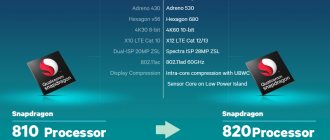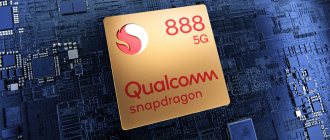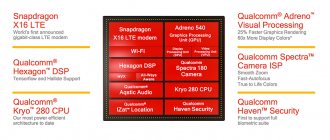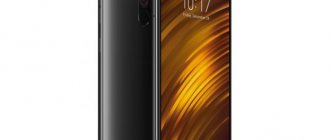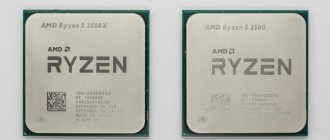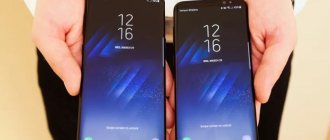A brief overview of the most interesting and advanced smartphones that have received an overclocked Qualcomm Snapdragon 821 chipset and other advanced specifications.
The Snapdragon 821 processor has recently appeared on the smartphone market and is an overclocked version of the Snapdragon 820. As with its predecessor, it is based on a 14-nm FinFET Low Power Plus process technology and four computing cores, but their operating frequency has increased from 2.1 GHz up to 2.4 GHz.
The first smartphone to receive the new chipset was ASUS Zenfone 3 Deluxe, which never became available for general sale, followed by devices from other mobile manufacturers. We have made a small selection of the best offers based on the Snapdragon 821 processor.
Google Pixel XL
The Pixel XL smartphone turned out to be one of the most anticipated new products of the fall. Despite the rather bold decision to release a device under an unknown brand, without even mentioning the Taiwanese manufacturer HTC and setting such a high price tag, Google managed to make an interesting and marketable smartphone. It is reported that all copies of the widescreen smartphone have already been sold out in the Google Store.
The device provides users with exclusive features such as Google Assistant, free unlimited storage in Google Photos for storing full-size photos and videos, Pixel Launcher and support for the Daydream VR platform. It is impossible not to note the unusual combination of glass and metal on the back panel.
The gadget received a 5.5-inch AMOLED display with a resolution of 2560×1440 pixels and Gorilla Glass protective coating, 4 GB of RAM, 32/128 GB of internal memory without expandability, a 3450 mAh battery with Quick Charge 3.0 fast charging function, protection against dust and vertical splashes according to IP53 certification. Above the screen is an 8-megapixel front camera with f/2.4 aperture.
The manufacturer paid special attention to the main camera. It is represented by a 12.3-megapixel Sony IMX378 sensor with a pixel size of 1.55 microns, f/2.0 aperture, LED flash and phase detection autofocus. There is support for the advanced HDR+ mode by default, as well as 4K video shooting with electronic stabilization - competitors cannot yet offer this.
The smartphone runs on the latest version of Android 7.1 Nougat operating system.
OnePlus 3T
Although the Chinese manufacturer assured us that it would not release more than one smartphone per year, it has happened - we have before us an improved version of the summer flagship, called OnePlus 3T.
One of the main innovations was the use of the upgraded Snapdragon 821 processor. In general, improvements have occurred here on almost all fronts, with the exception of a 5.5-inch Optic AMOLED screen, 6 GB of RAM, and the Android 6.0 Marshmallow operating system (which will be updated very soon up to Android 7.0 Nougat) and metal design.
Users can choose from 64GB and 128GB storage options. A 3400 mAh battery is responsible for providing the necessary energy. Photo and video capabilities should improve significantly thanks to the 16-megapixel main camera with a Sony IMX298 sensor, LED flash, phase detection autofocus, optical and electronic stabilization (the latter works even during video shooting in 4K format). The manufacturer has not forgotten about selfie lovers - for them there is a 16-megapixel front camera with phase detection autofocus and electronic image stabilization.
Sample tests for Snapdragon 820 and 821 processors
The test sample, in addition to the new processor, was supplemented with:
- RAM 3 GB;
- built-in memory 64 GB;
- camera - 21 MP;
- operating system Android 6.0.
- Fingerprint's scanner.
The test was carried out on the latest version - AnTuTu V6.0. The test results were simply stunning. With the SD 820 processor, the smartphone earned 131,648 points. As for the performance test results, GPU testing in the GFX 3.0 Manhattan test showed that the Snapdragon 820 with Adreno 530 GPU managed to beat the iPhone 6s Plus and Google Pixel C tablet, which are powered by Nvidia's strong Maxwell Tegra X1. In GFX 3.1 Manhattan - Adreno 530 lost second place, delivering only 31.5 FPS compared to 35.5 FPS in Google Pixel C, but at the same time it is almost twice as powerful as Huawei Nexus 6P with Adreno 430.
Test results for Snapdragon 820 and 821 processors
We took Le Pro 3 (Snapdragon 821) and Le Eco Le Max 2 (Snapdragon 820).
AnTuTu Benchmark
One of the most famous applications for studying the capabilities of processors built into phones and tablets. It analyzes and compares such characteristics as processor power and graphics playback speed, RAM efficiency and the speed of additional (external memory). Using the application, you can improve the performance of your mobile device thanks to the additional capabilities of the program.
AnTuTu 3D Bench
A more advanced and complex version of the previous application, it allows you to test the device’s performance when running “heavy” games and check the compatibility of installed applications with the gadget. The process follows three different schemes based on OpenGL 3.1 Coastline, OpenGL 3.0 Marooned, OpenGL 3.1+AER Refinery engines.
3DMark (Sling Shot Extreme)
A well-known free performance analysis application created specifically for gamers. It is an industry standard program used to test the performance of GPUs and other hardware and rank new device models.
Work 2.0 benchmark
It will help you find out how the device copes with processing everyday processes, such as editing videos and photos, as well as browsing websites and working with documents and files. Analysis based on real applications determines performance and battery life.
Geekbench 4
It is the most rigorous and detailed test of a device, helping to measure the performance of the processor and RAM when performing application tasks in single-core and multi-core modes. Built-in settings in the program allow you to check battery performance. Often, a device scores the highest in synthetic studies, but slows down in field tests.
Epic Citadel
This testing based on Unreal Engine 3 allows you to find out what graphics quality is supported in the phone (or not supported). The principle of operation of the application is not on the usual output of results in the form of numbers, but on watching a video. Textures close to reality, detailed illustrations, and bright pictures make it possible to evaluate the test result with your own eyes by watching the test video. It is possible to select and configure graphics for testing to select the appropriate one.
Xiaomi Mi5S Plus
The device was presented not so long ago, but has already received second place in the performance rating from the AnTuTu benchmark. The reason for this is the same powerful Snapdragon 821 processor. The gadget is equipped with a 5.7-inch screen with a resolution of 1920×1080 pixels and Gorilla Glass 4, 4/6 GB of RAM, 64/128 GB of physical memory and a 3400 mAh battery with support for fast charging Quick Charge 3.0. There is also a universal USB Type-C connector.
The main feature was the dual camera on the rear panel, consisting of two 13-megapixel sensors - color and monochrome. The manufacturer uses all the features provided by the Snapdragon 821 processor, including the Clear Sight platform. So far, this is the first smartphone that uses new technology from Qualcomm to create high-quality photos with a dual camera in any lighting. The front camera shoots with a resolution of 8 megapixels.
Snapdragon 821 processor: evolution of the 820 chipset
After the resounding success of the Snapdragon 820 chipset, Qualcomm decided to develop a series of 14-nanometer models by releasing an even faster Snapdragon 821 processor. The main reason for the release of the 821 model was the too early launch of the Snapdragon 820 (beginning of the year) and the fact that by the second half of 2016 the chipsets Qualcomm has emerging very serious competitors - Samsung Exynos 8890, HiSilicon Kirin 955 and Apple A10. By the end of the year, the list of competitors was supplemented by a new processor from Huawei - Kirin 960 (Huawei Mate 9, Huawei P10 and P10 Plus).
In the wake of interest in fresh chips from competitors, Qualcomm partners proposed the idea of creating a more powerful processor. According to the plans of partner brands, smartphones with the new Snapdragon 821 processors could compete with the new iPhone, Galaxy S and Huawei products.
To do this, the four Kryo cores of the 820 model were overclocked to 2.34 and 2.00 GHz, increasing performance by 10%. In addition, Qualcomm also upgraded the Adreno 530 graphics core, increasing the frequency from 624 to 650 MHz. All other characteristics of the Snapdragon 821 were copied from the previous chip.
This simple move allowed phones with Qualcomm Snapdragon 821 processor to show more impressive results in AnTuTu Benchmark and Geekbench Browser. At the time of the release of the 821st chipset, the most powerful model on the Snapdragon 820 – Vivo Xplay 5 elite – scored 138,706 points in AnTuTu Benchmark. After assembling and running the test model on the Snapdragon 821, the results increased to 150,000 points, and the finished smartphones showed more impressive numbers.
The most powerful processor of 2016 - Snapdragon 821
What do you know about mobile processors? Most likely, there are weak chips, mid-performance and powerful microprocessors installed in flagships. So, every day many smartphones appear, the heart of which becomes one of the above chips.
Among budget devices, processors from Mediatek are mainly common; mid-price smartphones use stones from Mediatek and Qualcomm approximately equally, but flagships are equipped with chipsets from Qualcomm in 99% of cases.
It is impossible to say specifically what this is connected with, since the popularity of chipsets depends on price, performance, and the reputation (+ promotion) of their manufacturer. Until mid-summer of this year, the most powerful processor was the Qualcomm Snapdragon 820 with four computing cores, 64-bit architecture and a frequency of up to 2.15 GHz. However, now the Snapdragon 821 intermediate chip has come into play, according to Qualcomm, which is slightly modified and has even more power. The manufacturer claims that the Snapdragon 821 is not a replacement for the 820 model, but is only being released in order to further establish itself in the mobile solutions market before the release of the next full-fledged flagship solution. Well, let's figure out what the Snapdragon 821 offers and how much better it is than its predecessor.
Xiaomi Mi Mix
Although a considerable amount of time has passed since the announcement, the smartphone is still popular thanks to its unusual ceramic body, innovative sound transmission technology and a screen that occupies almost the entire front panel. It was the release of Xiaomi Mi Mix that prompted many other manufacturers to try to realize themselves in the field of frameless design.
The gadget is equipped with a 6.4-inch screen with a resolution of 2040x1080 pixels, although due to the thin frames the company managed to make the body comparable in size to 6-inch and 5.7-inch devices. The rest of the specifications meet the high bar set by its attractive appearance: a powerful Snapdragon 821 processor, 4/6 GB of RAM, 128/256 GB of permanent memory, a 4400 mAh battery, a 16-megapixel rear camera and a 5-megapixel front camera that has moved under the display along with sensors.
The software platform is Android 6.0 Marshmallow with the proprietary MIUI 8 shell out of the box.
Results
The Snapdragon 821 led in 4 out of 5 tests, showing confident superiority even taking into account the smaller amount of RAM in a particular device. The gap did not turn out to be critical - the processors are very similar in characteristics. However, sometimes even a small advantage turns out to be decisive - for example, for lovers of resource-intensive toys. As they say: it’s a small thing, but it’s nice!
Now let’s wait until we get our hands on devices with the 830th and 835th “Dragons”: that’s where the tests should show a really serious difference.
Detailed reviews of the devices - Le Max 2 and Le Pro 3 - are available on Trashbox.
Xiaomi Mi Note 2
Another flagship smartphone from a Chinese manufacturer. Here, too, high-end equipment could not be avoided, which perfectly complements the powerful Snapdragon 821 processor. All together helped the device take an honorable fourth place in the November ranking of the most powerful Android devices compiled by the AnTuTu service.
The smartphone is equipped with a 5.7-inch OLED display with Full HD resolution, a 4070 mAh battery, 4/6 GB of RAM and 64/128 GB of physical memory. The company placed special emphasis on the rear camera with a 22.56-megapixel Sony IMX318 sensor, dual-tone LED flash, hybrid autofocus and electronic image stabilization. On the front panel there is an 8-megapixel front camera.
Pros and cons of Qualcomm Snapdragon 821 MSM8996 Pro
Advantages
- Has built-in LTE;
- RAM speed 1866 MHz. This parameter is higher than 61% of similar products;
- Has integrated graphics;
- Supports 64-bit system;
- Semiconductor size 14 nm. This parameter is lower than 93% of similar products;
- Uses big.little technology;
Flaws
- Processor execution thread 4. This parameter is lower than 78% of similar products
LeEco Le Pro 3
According to testing results in AnTuTu, this is the most powerful smartphone running the Android software platform. The device is housed in a metal body with a textured finish and is only 7.5 mm thick - and this is with a 4070 mAh battery. There is support for Quick Charge 3.0 fast charging via the USB Type-C connector; the same port is used to connect a headset, since the gadget does not have a 3.5 mm input.
The smartphone is equipped with a 5.5-inch IPS LCD display with Full HD resolution and protective glass with a 2.5D effect. A wide range of options are available with different memory capacities: 4/32 GB, 4/64 GB, 6/64 GB and 6/128 GB - the buyer will be able to choose the best option for him. On the back of the body there is a fingerprint sensor and a 16-megapixel main camera equipped with an f/2.0 aperture, phase detection autofocus and a dual-tone LED flash. On the front panel there is an 8-megapixel front camera.
The device operates under the Android 6.0.1 Marshmallow mobile platform with proprietary firmware EUI 5.8.

